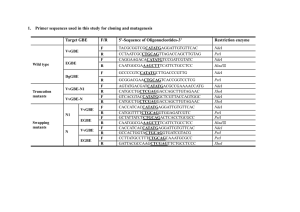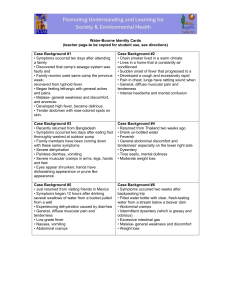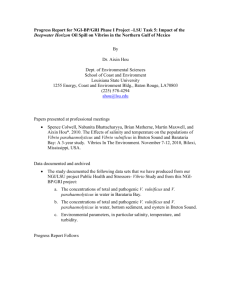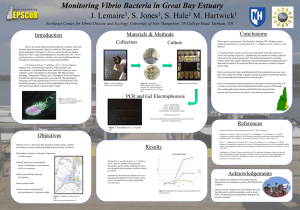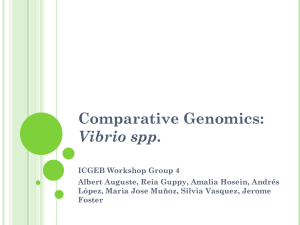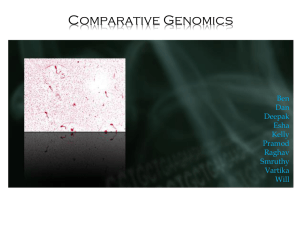British Journal of Pharmacology and Toxicology 3(2): 93-97, 2012 ISSN: 2044-2467
advertisement
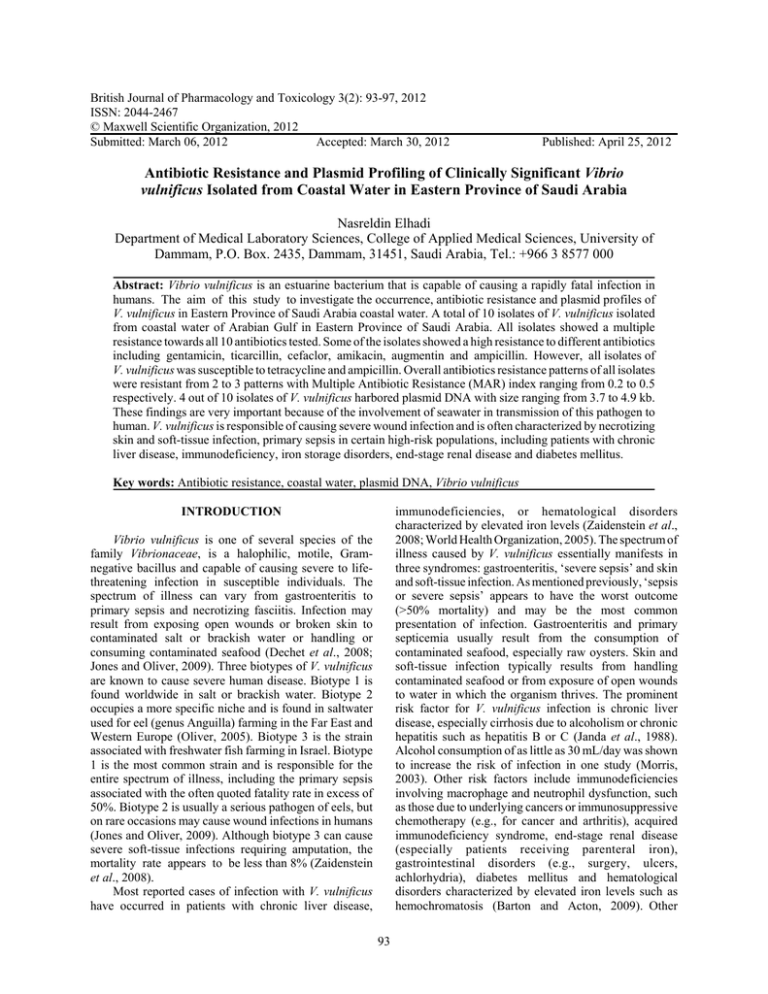
British Journal of Pharmacology and Toxicology 3(2): 93-97, 2012 ISSN: 2044-2467 © Maxwell Scientific Organization, 2012 Submitted: March 06, 2012 Accepted: March 30, 2012 Published: April 25, 2012 Antibiotic Resistance and Plasmid Profiling of Clinically Significant Vibrio vulnificus Isolated from Coastal Water in Eastern Province of Saudi Arabia Nasreldin Elhadi Department of Medical Laboratory Sciences, College of Applied Medical Sciences, University of Dammam, P.O. Box. 2435, Dammam, 31451, Saudi Arabia, Tel.: +966 3 8577 000 Abstract: Vibrio vulnificus is an estuarine bacterium that is capable of causing a rapidly fatal infection in humans. The aim of this study to investigate the occurrence, antibiotic resistance and plasmid profiles of V. vulnificus in Eastern Province of Saudi Arabia coastal water. A total of 10 isolates of V. vulnificus isolated from coastal water of Arabian Gulf in Eastern Province of Saudi Arabia. All isolates showed a multiple resistance towards all 10 antibiotics tested. Some of the isolates showed a high resistance to different antibiotics including gentamicin, ticarcillin, cefaclor, amikacin, augmentin and ampicillin. However, all isolates of V. vulnificus was susceptible to tetracycline and ampicillin. Overall antibiotics resistance patterns of all isolates were resistant from 2 to 3 patterns with Multiple Antibiotic Resistance (MAR) index ranging from 0.2 to 0.5 respectively. 4 out of 10 isolates of V. vulnificus harbored plasmid DNA with size ranging from 3.7 to 4.9 kb. These findings are very important because of the involvement of seawater in transmission of this pathogen to human. V. vulnificus is responsible of causing severe wound infection and is often characterized by necrotizing skin and soft-tissue infection, primary sepsis in certain high-risk populations, including patients with chronic liver disease, immunodeficiency, iron storage disorders, end-stage renal disease and diabetes mellitus. Key words: Antibiotic resistance, coastal water, plasmid DNA, Vibrio vulnificus immunodeficiencies, or hematological disorders characterized by elevated iron levels (Zaidenstein et al., 2008; World Health Organization, 2005). The spectrum of illness caused by V. vulnificus essentially manifests in three syndromes: gastroenteritis, ‘severe sepsis’ and skin and soft-tissue infection. As mentioned previously, ‘sepsis or severe sepsis’ appears to have the worst outcome (>50% mortality) and may be the most common presentation of infection. Gastroenteritis and primary septicemia usually result from the consumption of contaminated seafood, especially raw oysters. Skin and soft-tissue infection typically results from handling contaminated seafood or from exposure of open wounds to water in which the organism thrives. The prominent risk factor for V. vulnificus infection is chronic liver disease, especially cirrhosis due to alcoholism or chronic hepatitis such as hepatitis B or C (Janda et al., 1988). Alcohol consumption of as little as 30 mL/day was shown to increase the risk of infection in one study (Morris, 2003). Other risk factors include immunodeficiencies involving macrophage and neutrophil dysfunction, such as those due to underlying cancers or immunosuppressive chemotherapy (e.g., for cancer and arthritis), acquired immunodeficiency syndrome, end-stage renal disease (especially patients receiving parenteral iron), gastrointestinal disorders (e.g., surgery, ulcers, achlorhydria), diabetes mellitus and hematological disorders characterized by elevated iron levels such as hemochromatosis (Barton and Acton, 2009). Other INTRODUCTION Vibrio vulnificus is one of several species of the family Vibrionaceae, is a halophilic, motile, Gramnegative bacillus and capable of causing severe to lifethreatening infection in susceptible individuals. The spectrum of illness can vary from gastroenteritis to primary sepsis and necrotizing fasciitis. Infection may result from exposing open wounds or broken skin to contaminated salt or brackish water or handling or consuming contaminated seafood (Dechet et al., 2008; Jones and Oliver, 2009). Three biotypes of V. vulnificus are known to cause severe human disease. Biotype 1 is found worldwide in salt or brackish water. Biotype 2 occupies a more specific niche and is found in saltwater used for eel (genus Anguilla) farming in the Far East and Western Europe (Oliver, 2005). Biotype 3 is the strain associated with freshwater fish farming in Israel. Biotype 1 is the most common strain and is responsible for the entire spectrum of illness, including the primary sepsis associated with the often quoted fatality rate in excess of 50%. Biotype 2 is usually a serious pathogen of eels, but on rare occasions may cause wound infections in humans (Jones and Oliver, 2009). Although biotype 3 can cause severe soft-tissue infections requiring amputation, the mortality rate appears to be less than 8% (Zaidenstein et al., 2008). Most reported cases of infection with V. vulnificus have occurred in patients with chronic liver disease, 93 Br. J. Pharmacol. Toxicol., 3(2): 93-97, 2012 England). Antibiotics tested were gentamicin (10 :g), cefotxime (3 0 : g), ticarcillin (75 : g), trimethoprim/sulfamethoxazole (25 :g), norfloxacin (10 :g), cefaclor (30 :g), tetracycline (30 :g), amikacin (30 :g), augmentin (30 :g) and ampicillin (10 :g), Cultures derived from a single colony were grown at 35ºC. Overnight cultures grown at 35ºC were then spread over the Mueller Hinton agar plates using a sterile cotton bud and were allowed to dry for 2 to 5 min. Antibiotic discs were spaced out onto the plates and were incubated at 37ºC for 24 h. Diameter of the clear zone for each antibiotic disc was measured and interpreted as susceptible or resistant categories according to the guideline recommended by the Clinical Laboratory and Standards Institute (CLSI, 2007). The multiple antibiotic resistance index of the isolates was defined as a/b where ‘a’ represents the number of antibiotics to which the particular isolate was resistant and ‘b’ the number of antibiotics to which the isolate was exposed to (Krumperman, 1985). potential contributing factors include chronic disease, especially heart disease and advanced age (>60 years). Despite the importance of the emergence of V. vulnificus infections worldwide in the coastal areas, little is known about the presence of these organism in the marine environments of the region since the Arabian Gulf coast is one of the most important recreational areas in Gulf region. In the present study, we examined the presence of V. vulnificus in the five main sites in eastern coastal areas of this temperate coast of eastern province of Saudi Arabia. MATERIALS AND METHODS Isolation and identification of bacterial strains: A total of 300 water samples were collected from the Arabian Gulf coast at five different locations from February to December, 2010. A total of 90, 75, 60, 45 and 30 water samples were collected from Al Khobar, Half moon, Al Qatif, Al Azziziah and Dammam beaches respectively. All water samples were collected in sterile 500 mL glass bottles from a depth of approximately 10 to 15 cm and 10 to 15 m beyond the seashores. Water temperature was measured at all collection sites using temperature sensor and pH values ranged from 8.0 to 8.6 in all water samples. All water samples were transported to the Microbiology Laboratory (University of Dammam) in insulated cooler and examined immediately after their arrival. The transportation time arranged from 3 to 5 h. Inoculations into selective medium were made within 24 h after the collection of water samples. Plasmid DNA extraction: The Covalently Closed Circular (CCC) plasmid in V. vulnificus isolates were extracted by the alkaline denaturation procedure (Sambrook et al., 1989). The whole procedure was performed at room temperature. All bacterial strains were grown overnight in LB broth at 37ºC in an orbital shaker. The bacterial cells were pellets by centrifugation at 10,000 rpm for 1 min in a 1.5 mL micro centrifuge. The supernatant was carefully discarded and the cell pellet thoroughly resuspended in 150 L of glucose-EDTA-Tris buffer (GET buffer). After 10 min’s incubation on ice, 300 L of lysis buffer solution was added and the mixture was gently vortexes. The extracted plasmid DNA was precipitated and concentrated by using iso-propanol and alcohol respectively. The extracted plasmid in V. vulnificus isolates were followed by gel electrophoresis. In estimations of molecular weight of plasmids in V. vulnificus isolates, Escherichia coli strain V517 was used as molecular size markers. Escherichia coli strain V517 harbors 8 plasmids with molecular sizes of 2.1, 2.7, 3.0, 3.9, 5.1, 5.6, 7.2 and 54 kb (Marcina et al., 1978) respectively. Culture procedure: All samples were analyzed for potentially pathogenic Vibrios. 25 mL of test water sample was mixed with 225 mL Alkaline Peptone Water (APW) enrichment broth (1% peptone, 3% NaCl, pH 8.6) to isolate V. vulnificus (Elhadi et al., 2004). All samples enriched in APW were incubated for 18 to 24 h at 37ºC and from this enrichment culture was transferred with a loop on to Thiosulphate citrate bile salt sucrose agar (TCBS; Difco Laboratories, USA) and CHROMagar Vibrio (CV; Paris, France) and incubated at 37ºC for 24 h. After incubation 3 to 5 five colonies suspected to be V. vulnficus were picked up from the TCBS agar and CV plates and cultured on Tryptic Soy Agar (TSA) to obtain pure the colonies. Organism showing oxidase positive reactions were identified by using conventional biochemical methods described previously (Elhadi et al., 2004). Series number of biochemical tests and API 20 E system (BioMerieux, France) were used to identify V. vulnificus to species level. RESULTS A total of 300 water samples were obtained from five different location of Arabian Gulf. 90, 75, 60, 45 and 30 water samples were collected from Al Khobar, Half moon, Al Qatif, Al-Azziziah and Dammam beaches respectively. The highest numbers of V. vulnificus were isolated from Half moon and Al-Azziziah sites during the month of November and December, where the seawater temperature during sampling collection was 24 and 18ºC, respectively. The lowest numbers of V. vunlificus were isolated from Al-Khobar beach. All the isolates of Antimicrobial susceptibility tests: The antimicrobial susceptibility tests were performed essentially by the disc diffusion method as described elsewhere (Bauer et al., 1966), with disc containing antibiotic (Oxoid Ltd., 94 Br. J. Pharmacol. Toxicol., 3(2): 93-97, 2012 diversity of Vibrio species expected to occur during the warmer season (Michael and Salim, 2011). V. vulnificus is considered as an opportunistic infection which causes severe human infection in susceptible individuals and may cause mortality within 24-48 h of exposure and through wounds or consumption of contaminated seafood. V. vulnificus is a major bacterial cause of mortality associated with food-borne diseases and it results in the highest death rate (Todd, 1989). Diseases associated with V. vulnificus infection have been found to be present in two patterns (Harwood et al., 2004). In one, primary septicemia occurs in individuals with chronic liver disease shortly after eating raw oysters, with a mortality rate of over 50%. In the other pattern, wound infections are incurred via exposure to seawater or handling seafood products, with a death rate of approximately 25% (Blake et al., 1979). V. vulnificus infections have been reported in the USA, Europe and Asia (Hlady and Klontz, 1996). V. vulnificus has been detected in coastal and estuarine environments throughout the world, in areas with warm seawater temperatures (>20ºC) (Kelly, 1989). Most of the V. vulnificus isolates in this study were resistant to gentamicin, ticarcillin, amikacin, augmentin and ampicillin. However, norfoxacin, trimethoprim/ sulfamethoxazole and tetracycline were susceptible towards the isolates. Our results concur with data among the V. vulnificus and Vibrio spp. reported elsewhere (Manjusha et al., 2005) who isolated V. vulnificus with resistance to these antibiotics. Zanetti et al. (2001) and Ottaviani et al. (2001) found high susceptibility of V. vulnificus strains and other Vibrio spp to norfoxacin in concordance to the findings in our study. Our results showed that the second generation quinolones (norfoxacin) is the drug with the best antimicrobial effect against V. vulnificus in agreement with data reported by other authors (Zanetti et al., 2001). The MAR indices for the V. vulnificus were very high as shown in Table 1 and such high level of multiple resistances may arise from selective pressure due to the indiscriminate use of antibiotics. Animal farms release their effluent and water following antibiotic therapy on the farms (Schmidt et al., 2000) residual water from the industries plants where products containing microbial agents have been prepared and washed and the residual water is released directly into the sewage system (Guardabassi et al., 1998), which ultimately flows into the sea. MAR of V. vulnificus that is introduced into the marine environments readily contaminates the shellfish, which concentrate the marine microflora via filter feeding, subsequently causing a mutation in the cellular DNA (Zulkifi et al., 2009). These observations have been seen to contribute to the occurrence of MAR Salmonella and Aeromonas hydrpohila, respectively, in marine environment and seafood (Vivekanandhan et al., 2002; Martinez-Urtaza et al., 2004). Plasmid analysis of all the isolates as shown in Table 1 provided a general picture that revealed Fig.1: Appearance of V. vulnificus green blue colonies on CHROMagar vibrio (CV) medium Table 1: V. vulnificus strains used in this study Multiple antibiotic Plasmid resistance index DNA size Strain Antibiotic resistance* (MAR) (Kb) VV8 CN, TIC, AMP, 0.3 4.8 VV13 CN, TIC, AK, AMC, AMP 0.5 3.7 VV14 CN, TIC, AMP 0.3 VV23 CN, TIC, AK, AMC, AMP 0.5 VV26 CN, TIC, AK, AMC, AMP 0.5 4.8 VV27 TIC, AMP 0.2 VV28 CN, TIC, CEC, AMC, AMP 0.5 VV29 CN, TIC, AMC, AMP 0.4 VV30 CN, TIC, AK, AMC, AMP 0.5 4.9 VV31 CN, TIC, AK, AMC, AMP 0.5 *: Tested for gentamicin (CN), ticarcillin (TIC), cefaclor (CEC), amikacin (AK), augmentin (AMC) and ampicillin (AMP) V. vulnificus in this study were identified as biotype I because all the isolates were positive for indole production. CHROMagar Vibrio (CHROMagar; Paris, France) was used in this study in conjunction with TCBS agar because of its ability to isolate and identify V. vulnificus compared to the TCBS agar. CHROMagar Vibrio uses chromogenic technology to allow for the isolation and detection of V. vulnificus resulting in development dark blue colonies which can be distinguished from other Vibrio species as shown in Fig. 1. Ten isolates of V. vulnificus were tested for antibiotic susceptibility and plasmid DNA profiles. All the ten isolates of V. vulnificus demonstrated resistance to two or more antibiotics tested (Table 1). Out of 10 V. vulnificus isolates were screened for the presence of the plasmid DNA, only 4 isolates were harboring plasmid DNA range from 3.7 to 4.9 kb as shown in Table 1. DISCUSSION The main objective of this study was to determine the incidence of V. vulnificus in water samples collected from Arabian Gulf coastal areas that vary in water temperature and salinity. Seawater samples were analyzed during the summer months because of the greater number and 95 Br. J. Pharmacol. Toxicol., 3(2): 93-97, 2012 V. vulnificus contains plasmids. This finding correlates with results of previous studies, which have shown that V. vulnificus harbored plasmids (Radu et al., 1998). Molina-Aja et al. (2002) noted that 80% of the Vibrio strains analyzed harbor plasmids and 11 different plasmid profiles were observed. The plasmid profiles in our study revealed that 40% of the investigated V. vulnificus strains carried more than plasmids with diverse sizes. Antibiotic resistance in V. vulnificus in this study is presumably an innate rather than an acquired trait through plasmid transfer or antibiotic selection. This is proven by the presence of MAR V. vulnificus isolates but no plasmid was detected among these isolates. Nevertheless, the linkage of the presence of plasmids in the isolates to antibiotic resistance has not been determined. This study concluded that V. vulnificus is present in sea water of the Arabian Gulf coast of Eastern province of Saudi Arabia. Sporadic cases of V. vulnificus along the Arabian Gulf coast of Saudi Arabia still not reported yet but this research finding should prompt us to pay attention to the role of Vibrio vulnificus in wound infections. Facing any patient recently exposed to sea water and presenting infected wounds or septic shock, the possibility of infection caused by V. vulnificus must be thought about. Elhadi, N., S. Radu., C.H. Chen and M. Nishibuchi, 2004. Prevalence of potentially pathogenic Vibrio species in the seafood marketed in Malaysia. Food. Protect., 67: 1469-1475. Guardabassi, L., A. Petersen, J. Olsen and A. Daalsgard, 1998. Antibiotic resistance in Acinetobacter spp. isolated from sewers receiving waste effluent from a hospital and a pharmaceutical plant. App. Environ. Microbiol., 64: 3499-3502. Harwood, V.J., J.P. Gandhi and C. Wright, 2004. Methods for isolation and confirmation of Vibrio vulnificus from oysters and environmental sources: A review. J. Microbiol. Methods., 59: 301-316. Hlady, W.G. and K.C. Klontz, 1996. The epidemiology of Vibrio infections in Florida, 1981-1993. J. Infectious Dis., 73: 1176-1183. Janda, M., C. Powers, R. Bryant and S. Abbott, 1988. Current perspectives on the epidemiology and pathogenesis of clinically significant Vibrio spp. Clin. Microbiol. Rev., 1: 245-267. Jones, M.K. and J.D. Oliver, 2009. Vibrio vulnificus: Disease and pathogenesis. Infect Immun., 77: 1723-1733. Kelly, M., 1989. Effect of temperature and salinity on Vibrio (Beneckea) vulnificus occurrence in a gulf coast environment. Appl. Environmen. Microbiol., 44: 820-824. Krumperman, P.H., 1985. Multiple antibiotic indexing of E. coli to identify high-risk sources of fecal contamination of foods. Appl. Environ. Microbiol., 46: 165-170. Manjusha, S., G.B. Sarita, K.K. Elyas and M. Chandrasekaran, 2005. Multiple antibiotic resistances of Vibrio isolates from coastal and brackish water areas. Am. J. Biochem. Biotechnol., 1: 201-206. Marcina, D.J., K.R. Kopecko, Jones, D.J. Ayers and S.M. McCowan, 1978. A multiple-plasmidcontaining Escherichia coli strain: Convenient source of size reference plasmid molecules. Plasmid., 1: 417-420. Martinez-Urtaza, J., M. Saco, J. De Novoa, P. PerezPineiro, J. Peiteado, A. Lonzano-Leon and O. GarciaMartin, 2004. Infuence of environmental factors and human activity on the presence of Salmonella serovars in marine environment. Appl. Environ. Microbiol., 70: 2089-2097. Michael, H. and S. Salim, 2011. A comprehensive review of Vibrio vulnificus: An important cause of severe sepsis and skin and soft-tissue infection. Intern. J. Infect. Dis., 15: 157-166. Molina-Aja, A., A. Garcia-Gasca, A. Abreu-Grobois, C. Bolan-Mejia, A. Roque and B. Gomez-Gill, 2002. Plasmid profling and antibiotic resistance of Vibrio strains isolated from cultured penaied shrimp. FEMS. Microbiol. Lett., 213: 7-12. ACKNOWLEDGMENT This research study was supported by University of Dammam from the Deanship of Scientific Research. The author would like to thank the Microbiology Laboratory technicians (Mr. Lauro Bartolome and Mr. Bader Sager) for their contribution. REFERENCES Barton, C. and R. Acton, 2009. Hemochromatosis and Vibrio vulnificus wound Infections. J. Clin. Gastroenterol., 43(9): 890-893. Bauer, W., W. Kirby, J. Sheris and M. Turck, 1966. Antibiotics susceptibility testing by standardized single disk method. Am. J. Clin Path., 45(4): 493-496. Blake, A., M. Merson, R. Weaver, D. Hollis and P. Heublein, 1979. Disease caused by a marine Vibrio: Clinical characteristics and epidemiology. N. Engl. J. Med., 300(1): 1-5. CLSI, 2007. Performance Standards for Antimicrobial Susceptibility Testing. Seventeenth Informational Supplement. M100-S17. Wayne, PA: Clinical and Laboratory Standards Institute. Dechet, A.M., P.A. Yu, N. Koram and J. Painter, 2008. Nonfoodborne Vibrio infections: An important cause of morbidity and mortality in the United States, 1997-2006. Clin. Infect. Dis., 46: 970-976. 96 Br. J. Pharmacol. Toxicol., 3(2): 93-97, 2012 Todd, E.C., 1989. Costs of acute bacterial foodborne disease in Canada and the United States. Int. J. Food. Microbiol., 9: 313-326. Vivekanandhan, G., K. Savithamani, A.A.M. Hatha and P. Lakshmanaperum-alsamy, 2002. Antibiotic resistance of Aeromonas hydrophila isolated from marketed fish and prawn of South India. Int. J. Food. Microbiol., 76: 165-168. World Health Organization, 2005. Risk assessment of Vibrio vulnificus in raw oysters: Interpretative summary and technical report. World Health Organization, Geneva. Zaidenstein, R., C. Sadik, L. Lerner, L. Valinsky, J. Kopelowitz and R. Yishai, 2008. Clinical characteristics and molecular subtyping of Vibrio vulnificus illnesses, Israel. Emerg. Infect. Dis., 14: 1875-1882. Zanetti, S., T. Spanu, A. Deriu, L. Romano, L.A. Sechi and G. Fadda, 2001. In vitro susceptibility of Vibrio spp. isolated from the environment. Int. J. Antimicrob. Agents., 17: 407-409. Zulkifi, Y., N.B. Alithleen, R. Son, S.K. Yeap, M.B. Lesley and A.R. Raha, 2009. Identification of Vibrio parahaemolyticus isolates by PCR targeted to the toxR gene and detection of virulence genes. Int. Food Res. J., 16: 289-296. Morris Jr, J.G., 2003. Cholera and other types of vibriosis: A story of human pandemics and oysters on the half shell. Clin. Infect. Dis., 37: 272-280. Oliver, J.D., 2005. Wound infections caused by Vibrio vulnificus and other marine bacteria. Epidemiology. Infect., 133: 383-391. Ottaviani, D., I. Bacchiocchi, L. Masini, L. Francesca, A. Carraturo, M. Giammarioli and G. Sbaraglia, 2001. Antimicrobial susceptibility of potentially pathogenic halophilic vibrios isolated from seafood. Intern. J. Antimicrob. Agents, 18: 135-140. Radu, S., Elhadi, N. Hassan, Z. Rusul, G. Lihan, S. Fifadara, N. Yuherman and E. Purwati, 1998. Characterization of Vibrio vulnificus isolated from cockles (Anadara granosa): Antimicrobial resistance, plasmid profiles and random amplification of polymorphic DNA analysis. FEMS. Microbiol. Lett., 165: 139-143. Sambrook, J., E.F. Fristch and M. Maniatis, 1989. Molecular Cloning: A Laboratory Manual. 2nd Edn., Cold Spring Harbor Laboratory Press, New York. Schmidt, A.S., M.S. Bruun, I. Daalsgaard, K. Pederson and J.L. Larsen, 2000. Occurrence of antimicrobial resistance in fish-pathogenic and environmental bacteria associated with four Danish rainbow trout farms. App. Environ. Microbiol., 11: 4908-4915. 97
